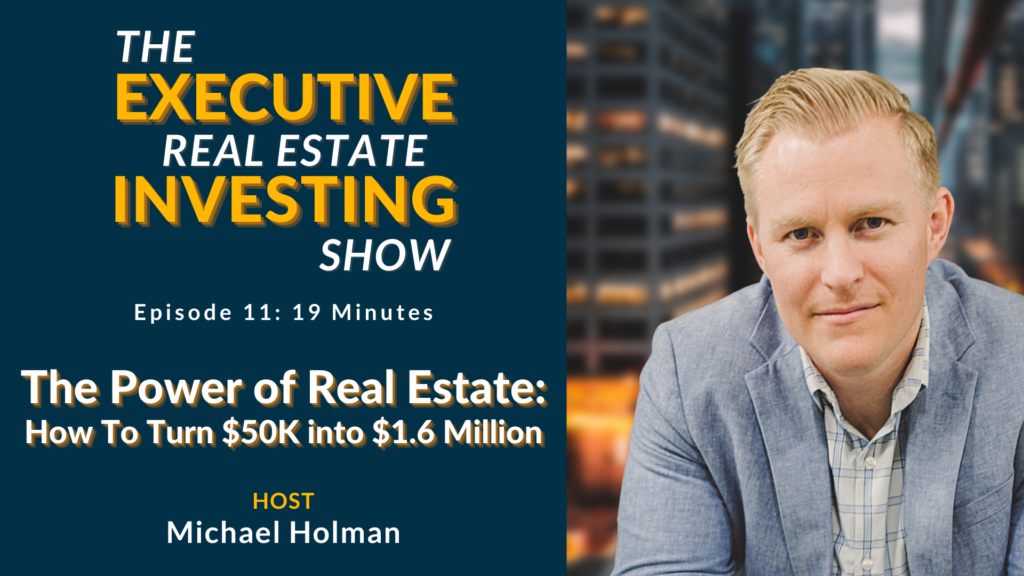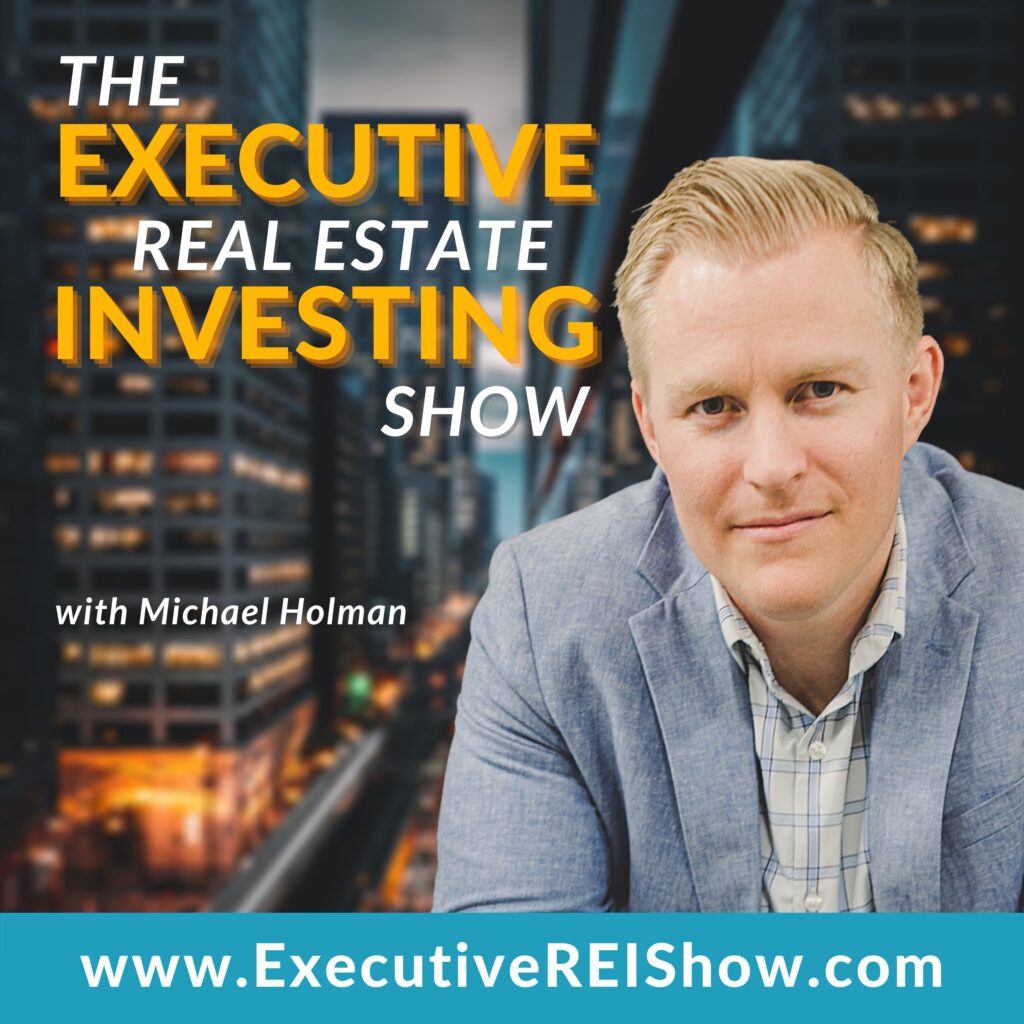
The executive Real estate investing Show
EPISODE 11
The Power of Real Estate: How To Turn $50K into $1.6 Million with Michael Holman
- August 16, 2021
EPISODE SUMMARY
This week on the show, host Michael Holman shares the power of real estate investing.
He breaks down with simple math and example how anyone can take $50,000 into $1,600,000 million dollars as well how this 1.6 million will become passive cashflow for you down the road. Listen and watch the YouTube video for the visual representation of this concept. He discusses the value of investing in smart real estate and what return numbers should be targeted and the exact timeline to follow so listeners understand how to make this happen.
As always, Michael gives his executive tip and gives relevant real estate advice and information.
EXECUTIVE TIP
Be Creative
There is no rule that stipulates that deals have to be made in the exact same way every single time, so don’t be afraid to think outside the box and let your creativity merge with your investment and business ventures.
LISTEN TO THE PODCAST HERE

The Executive Real Estate Investing Show Podcast
EP 11: The Power of Real Estate: How To Turn $50K into $1.6 Million with Michael Holman
Listen on
READ THE TRANSCRIPT HERE
Note: Audio transcription has been automatically transcribed
Welcome to the Executive Real Estate Investing Show. This podcast is for you, the busy business owner or executive looking to create generational wealth. Here, we’re going to show you how to do that through real estate investing. Through multi-family to industrial, and everything in between. You will become a real-estate investing expert. And now, here’s your host, Michael Holman.
Hello everyone and welcome to another episode of the Executive Real Estate Investing Show. Excited to be here with you today, if you’re watching the YouTube video right now, you can see that obviously we are in a little bit of a different location and that is for good reason. If you’re listening to the podcast it’s still going to be great, but we are writing all over this class right now because we are going to show you something pretty special on how powerful real estate investing really can be. So, if you’re listening to the podcast, that’s great, you can listen to the podcast, highly recommend you go check out the YouTube channel and see this and watch it live. Because, like I said, we’re going to be writing all over this class today, really excited to talk about this.
But before we get into what I am so excited to show you today about real estate investing, we’re going to start with the executive tip. So, the executive tip for this week: be creative. Too many people in business, in real estate, in everything they’re doing, they get stuck in this box, right, “this is how thing are done, this is the way it happens, and there’s no going outside of this box.” Well, guess what? Deals get done all of the time outside of the box and you just have to get creative sometimes. I mean, this happens all of the time in real estate, in business, right? Be willing to think outside the box, get creative, and that’s okay, you can—as long as you can explain that to the shareholders, to the lenders, to the interested parties, and you can explain why you’re being creative, that often times is viewed as actually really beneficial. So, don’t be afraid to get outside the box sometimes.
Okay, now, moving into what we’re going to talk about. Today we are going to talk about the power of real estate investing. So, we are going to show you how you can turn fifty thousand dollars into one point six million dollars. Right, probably sounds too good to be true, I’m not trying to do any clickbait or anything here, this is honest-to-goodness truth on how this can work. So, we are going to start here, as I said, fifty thousand dollars into one point six million dollars. We’re going to do some simple math and show you how this is possible over the course of twenty-five years.
Okay, so if you start here with a fifty-thousand-dollar investment, okay, you have one fifty-thousand-dollar investment. We’re going to use real estate syndications, all right, because this is probably the most common tool to make this kind of thing happen. So, you’re going to take that fifty thousand dollars and you’re going to invest it into real estate, okay? We’re going to call this a real estate syndication and let’s say that that real estate syndication, which is very, very common, is trying—is targeting a 2x equity multiple, okay? What that means is they’re trying to take your—that fifty thousand dollars and they’re trying to make it a hundred thousand dollars over a five-year hold, okay? This is the equivalent—so a 2x equity multiple is the equivalent of a twenty percent annualized return, okay? All super common stuff. So, here’s what happens, and bear with me as we erase some things here—so, here’s what happens. Let’s say that is the goal, and that is the target, right? You’re targeting real estate syndications that are going for a 2x equity multiple every five years. Happens all the time, very, very doable, okay? And you can take this and say, “okay, some might do a little bit better than that and some might do a little bit worse, but we are going to target a 2x equity multiple,” well, here’s what happens, okay? Year zero, okay, you invest that fifty-thousand dollars, okay, here’s what happens. Year five, that fifty-thousand dollars then becomes a hundred thousand dollars, year ten, that fifty thousand dollars they turned into a hundred thousand dollars, that now becomes two hundred thousand dollars. All right still got a ways to go. Now the two hundred thousand dollars, you double that because you’re going a 2x equity multiple every single time. Now look at this, year fifteen, okay, that’s four hundred thousand dollars. As we continue on here, we’re going to jump up over here, now all of a sudden, the four hundred thousand dollars turns into eight hundred thousand dollars in year twenty. And just like we talked about at the very beginning, by year twenty-five, okay, that eight hundred thousand dollars now turns into one point six million dollars.
What you’ve done is you’ve just taken these fifty thousand dollars, you haven’t—you haven’t put a single penny more into any of this, right, you simply made one fifty-thousand-dollar investment. You are now, after twenty-five years, you’re now sitting on one point six million dollars. And this is—this kind of thing happens all the time, right, the key is to average a 2x equity multiple every five years. Okay, if you do that, or in other words, a twenty percent annualized return, okay, uh—oftentimes it’s AAR (Average Annualized Return). Okay, look at that, I mean, seriously, you didn’t do—you didn’t do anything here. You made smart investments, right, you—if you invest in a real estate syndication, completely passive, right? You’re—you’re not doing anything except providing the money and then you’re just making sure that you’re rolling. So, your money is always working for you, okay, all of a sudden too you start thinking about cash flow, right, because that’s a big thing. Everybody starts talking about cash flow, “I want cash flow, I want to have all of this,” and that—that’s great, right. If you’ve been listening to the show for a while you know I’m a big proponent of cash flow, but I think sometimes people get too wrapped up solely in cash flow, right, and sometimes people get oversold because they don’t have, uh—they don’t have any other mindset besides “cash flow, cash flow, cash flow” and cash flow can sometimes be a finnicky thing so you’ve got to take into account all of your returns.
But that being said, okay, we’re going to look at cash flow here for a second. So, let’s take this, right, after twenty-five years, right, your fifty thousand dollars now just became one point six million dollars. Okay, let’s do—let’s do some math here, okay, some simple math. If we take that one point six million dollars, let’s say that one point six you’re—you’re doing really good, okay, we call it a ten percent cash on cash return. Okay, now all of a sudden you have that one point six million dollars, it’s turning into a ten percent cash on cash return, well that—what used to be twenty-five years ago fifty thousand dollars—that’s now bringing you a hundred and sixty thousand dollars of completely passive cash flow, okay? That’s pretty amazing, right? All of a sudden you just turned one fifty-thousand-dollar investment right, that at the time—right, same math, that fifty thousand dollars that would be five thousand dollars a year in passive cash flow, that’s now a hundred and sixty thousand in passive cash flow. So, whether your goal is asset accumulation or cash flow, this makes all the sense in the world, right? It’s using time, right, time is your friend in this equation.
So, if you are, you know—let’s say you’re a young professional, right, you’re thirty-five, forty, right, you might have just reached credited status, you’re feeling good, you want to—you haven’t—finally have a little bit of extra money to invest in, right? Well, let’s take the time frame here, so let’s say thirty-five years you invest your first fifty thousand dollars, okay, well, in twenty-five years from then, what, you’re sixty? Sixty years old, yeah even to retirement age at that point, I mean most people nowadays are working till they’re sixty-five, that number just keeps going up every single year. You have now established retirement worthy money before you even hit retirement, I mean you start retiring early at that point. That’s, I mean, that’s huge.
So we just talked about if you took one fifty-thousand-dollar investment, right, and did nothing with it. Now let’s get crazy, right, let’s say you put in a hundred-thousand-dollars, okay, let’s go over that same twenty-five-year period. All right, well, this is pretty simple math because it’s simply just going to be double what your first investment was, all right? So maybe this is across two, three investments, maybe this is all into one. Well now you take that hundred-thousand-dollars over a twenty-five-year period—I’m going to save you from outlining all the math again, but let’s see what that ends up as. Three point two million dollars, right? If you’re thirty-five, by the time you’re sixty years old, three point two million dollars. I mean, come on, and that’s for one hundred-thousand-dollar investment or two fifty-thousand-dollar investments. Time is on your side here, right, the more time you have, the more ability you have to do this kind of thing.
You’re never—and that’s the thing—you’re never getting there. I mean the average stock return is—risk-free, risk-free return on the stocks is six to eight percent. Okay? That is your risk-free return, and I know some of you are saying, “well, stocks are going like crazy,” yeah, they’re sitting here in the ninety-ninth percentile and they continually hit the ninety-ninth percentile for the last, like, two or three months. I don’t know how everyone else feels, but I feel like the stock market right now is a ticking time bomb, right? It’s just ready to go off at some point. You’re looking—the power of this, the six to eight percent, is just not cutting it, right? You need to be—if you’re going to make something like this work you need to be in the fifteen to twenty-five percent average annual returns, okay? If you’re not somewhere in this realm, then what I’m saying is, “never going to work.” And that’s why people—have you ever wondered—people are constantly putting into their 401K, right, they’re putting money into their 401K all the time and yet none of them, you know—there’s not a lot of people who are coming out super well-to-do, right? It’s because they’re not investing in the right kinds of things. If they would just make smart investments with that money, they could probably exponentially increase that, right? But they come in, they do some target mutual fund that averages them like a six percent return and then you have the fees taken out, next thing you know, that person’s never, they’re—it’s practically a savings account at that point, right? You’re making like two, three percent maybe. Ridiculous. That’s not how we’re going to work here, right, that is the power of real estate investing.
I mean we—let’s go over a third scenario, right? Let’s make this one a little bit different, okay? Let’s say you’re saying, “I don’t have a hundred thousand dollars to invest right now, but I think I could save up fifty thousand dollars a year for maybe a few years,” okay great, let’s look at this. So, all of a sudden you invest fifty thousand dollars in year one, well let’s say you invest another fifty thousand dollars, okay? Not in year one, and by year one I mean year zero, the initial period, right? Let’s say you invest another fifty thousand dollars, let’s do it at year five. Well, now all of a sudden you take that fifty thousand dollars that’s doubling, right, so that amount, that fifty thousand dollars is subsequently turning into the one point six million dollars that we just talked about, plus now you have these fifty thousand dollars which you saved up for five years, right? So, average ten-thousand-dollar savings a year to be able to invest another fifty-thousand-dollars, right? You bring that down after twenty-five years, that is now sitting at eight hundred thousand, well, all of a sudden now your total return on that, I mean, you’re two point four million, people. I mean look at this, the math just makes sense. If you make good investments, right, they are going to pay dividends and they are going to exponentially increase your power if—your power to invest, your power to earn money. All these people were talking about saving, right? I get it, and you have to be able to save to be able to invest, that’s great, but you have got—nothing is going to exponentially increase your wealth more than going from mediocre investments to great investments. If you’ve ever wondered, I mean, think about the wealthiest investment companies in the world, right, these people are constantly targeting twenty, twenty-five, thirty percent returns. They’re not settling for two, three, four, five, six percent returns that everyone else down here is constantly settling for because it’s easy, that’s what it is. It’s honestly harder to invest in real estate, right? It’s a little more difficult, it takes more work, you have to go out and find sponsors and you’ve got to vet them. I mean once you’re in it’s completely passive, but it takes a little more time to get to that point, to be able to find the person, to be able to have the confidence to put the fifty thousand dollars into that syndication, but this is making a huge, huge difference for you.
All right, so I’m going to recap one more time. Once again, we just talked about, right—and this is the power of real estate investing, right—we just outlined multiple scenarios but we’re going to go back to the most basic one on how you can invest fifty thousand dollars, not a dime more, and after twenty-five years you’re going to turn that into one point six million dollars. And here’s the key, right, here’s what I want you to target if you’re saying, “wow, this sounds great and fantastic and I’m going to do this,” well, you should. Let me tell you what you need to target. Okay, in order to make this happen, and I’ve said it a couple times, but I want to be crystal clear here so that you know what you have to do in order to make the scenario that I just outlined, what you have to do to actually make that happen. Okay, you need to target a twenty percent average return, okay? That, or in other words, you need to do a 2x equity multiple every five years. You can have a 2x equity multiple but if it takes you ten years, fifteen years to get to that 2x equity multiple you’re losing all the power of it, right? So, the key is a 2x equity multiple every five years, what that means is—that means that your fifty thousand dollars is turning into a hundred thousand dollars, your money is doubling every five years. That’s a twenty percent average annual return. Right, we’re not getting into IRR’s here, that’s a session for another day and IRR is a great thing, it’s a thing to know because everybody wants money sooner rather than later and that’s what it’s tracking. It’s great, right? But for these purposes you don’t even have to consider IRR, it doesn’t matter when you get the money.
At the end of the day you’re taking a fifty-thousand-dollar investment, and as long as you’re reinvesting that every five years into a good real estate investment, you end up with one point six million dollars. Your cash flow is easily six figures a year in that scenario, right? It doesn’t have to be ten percent, you can get down to eight percent, nine percent, it’s still six figures of completely passive cash flow, and that everybody, that is the power of real estate. That is how you become wealthy, that is how millions and millions of people have become wealthy, and it’s through real estate. More people are becoming millionaires through real estate investing than any other type of investing, and this is why. See you next week.
Thank you for listening to The Executive Real Estate Investing Show. Ready to learn more? Go to ExecutiveREIShow.com for more episodes and resources to help you create generational wealth through real estate investing. That’s ExecutiveREIShow.com.







